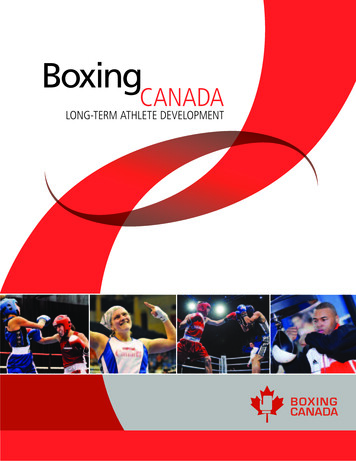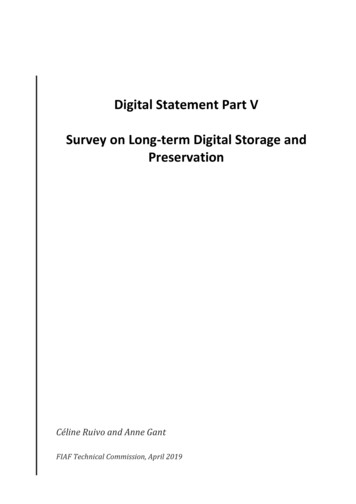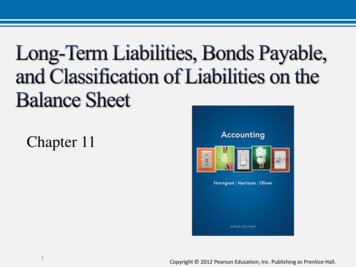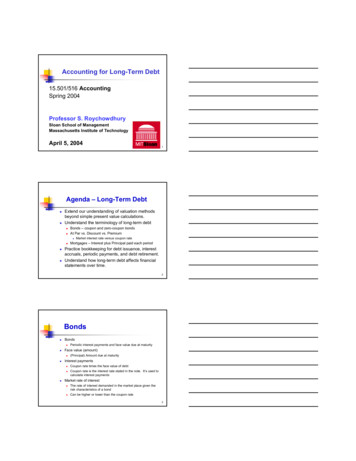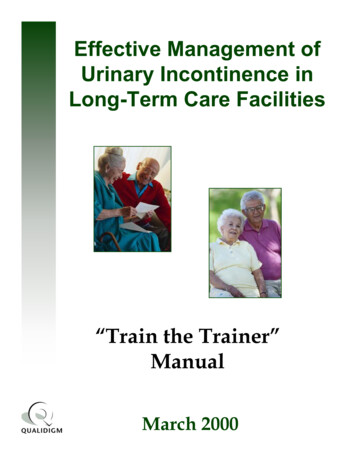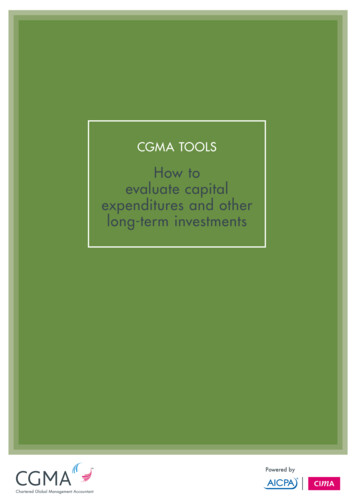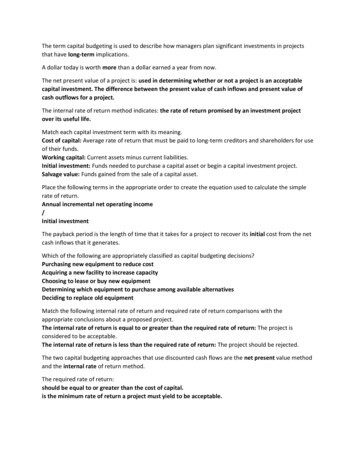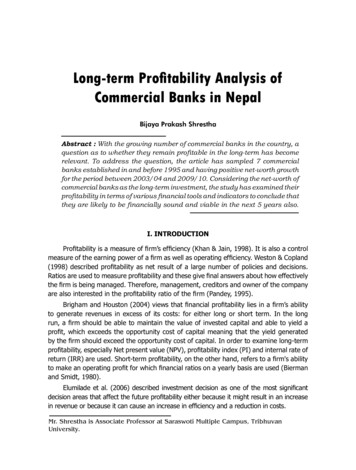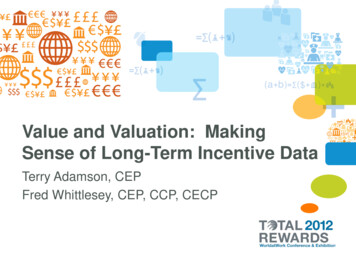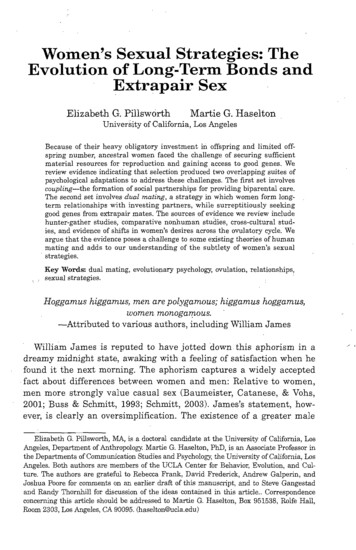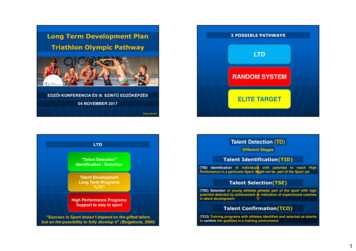
Transcription
Long Term Development Plan3 POSSIBLE PATHWAYSTriathlon Olympic PathwayLTDRANDOM SYSTEMEDZŐI KONFERENCIA ÉS III. SZINTŰ EDZŐKÉPZÉS04 NOVEMBER 2017ELITE TARGETSérgio SantosLTDTalent Detection (TD)Different Stages“Talent Detection”Identification / SelectionTalent DevelopmentLong Term Programs“LTD”High Performance ProgramsSupport to stay in sport“Success in Sport doesn’t depend on the gifted talent,but on the possibility to fully develop it” (Bulgakova, 2000)Talent Identification(TID)(TID) Identification of individuals with potential to reach HighPerformance in a particular Sport. Might not be part of the Sport yetTalent Selection(TSE)(TSE) Selection of young athletes already part of the sport with highpotential detected by achievement or indication of experienced coachesin talent developmentTalent Confirmation(TCO)(TCO) Training programs with athletes identified and selected as talentsto confirm the qualities in a training environment1
Talent DetectionTalent Development (TDE)Need to implement Talent Detection Programs We all have limited resources (human, financial, time); High performance is very demanding and can not beachieve by everybody;(TDE) Offering the best learning/training conditions to develop all theidentified Talent TID Is useless if not followed by a strong selection and developmentprogram The big investment should be done in the TDE every time we have thecapacity put on place an LTD program; Facilities do implement the Development program Coaching support; Training groups; Race calendar; As Coaches, we have the obligation to not create falseexpectation to young athletes. If we know from thebeginning that they will not achieve certain level, we can’tcontinue to create them “false” future scenarios (but for thatwe have to know it.); All kind of Triathlete is important for our sport, but formost part of them, high performance programs are not theright way;Financial ResourcesTalent DetectionTalent DetectionBenefits of TD Programs (Bompa, 1999)Where does the Talents come from? Reduce necessary time to achieve high performancelevel (gifted young athletes in the right sport); It eliminates big amounts of work, energy and talentfrom the coach; Reduce possible financial investment in athletes withlimited potential; It increases the competition level and number ofAthletes seeking for high performance (National Teamswith high quality Athletes and many of them, are theideal to development even more level); It increases Athlete self confidence (Competitionresults are usually better than other young Athletes withsame training level); High Performance Coaching teams are more motivatedto work even more when achieving good results;NOTRI SportBackground?CompetitiveTRIATHLONChampions can come from any of 3 sports;The easiest way seems to be from Swim Background;Some Swimmers seems to have problems to adapt tooutdoor activities; Is it possible to make High Performance Triathletes fromnon swim background? We can not shut doors! 2
Talent DetectionTalent DevelopmentWhere does the Talents come from?Specialization in TriathlonSchools?Swim Team? Swim cializationTrack and field Team? Running races?Cycling Team? Cycling races?Talent Detection Trials?Triathlon Clubs?Youth Triathlon Races?RUNLateSpecializationTalent DevelopmentTalent DevelopmentSpecialization in TriathlonSpecialization in TriathlonFEB 1987TRIATHLONMIXJUN 1982APR 1973Ye Shiwen born 1996Great North Run 2013200 and 400m Medley Gold in London 20123
Talent DevelopmentTalent DevelopmentCareer Plan – Sports with late specializationCareer Plan – Sports with late specializationBalyi, 1998Balyi, 1998Stage NameGirlsBoysFUNdamentals MotorSkills6-8years6-9yearsDiversification inFUNdamentals MotorsituationsGoalsLearning to Train8-11years9-12yearsAcquisition of “Sports”Motor Skill fundamentalsTrain to Train11-14years12-16yearsDevelopment of SpecificSport abilitiesTrain to Compete(Start of ic training foracquisition/developmentof specific motor Skills tocompeteTraining to Win18years 19years Retirement-ReconversionWhenLevel notenoughSpecific Training aimingHigh PerformancePost Career Activity. VeryWhenimportant for TriathletesLevel notsecurity after aenoughProfessional Sport careerTalent DevelopmentTalent DevelopmentLong Term PeriodizationLong Term Development – 10-10-10 RulePeriodizationAdapt. Bompa, ty 10 or 10.000 Hours Rule (Ericsson andCharness, 1994 and Salmela et al.,1999). This rule means more than 3daily hours of training for 10 years toaccomplish the 10.000 hours; A young athlete is considered talentedwhen situated in the upper 10%compared to his pears in h PerformanceAge This Rule means that we need 10 yearsto “build” a competitive Triathlete;7-97-811-1313-1518-2220-24Cycling (road)12-1516-1822-28 (38 ) This Rule means a maximum of 10 % intraining volume from one year toanother is a good security;Running (distance)14-1617-2025-28 (35 )SportSwimming:GirlsBoys4
Talent DevelopmentTalent DevelopmentLearning and Racing ProgressionLong Term Development – 10 % Increase SimulationStage NameCAREER1 Year2345 Years678910 YearsAGE16 Years Old17181920 Years Old2122232425 Years OldSessionskmTimeSWIM5-6 / 3-4k206:30BIKE2-3 / 40-60k1505:30RUN4-5 / 6-10k403:30COMPL.2 / 30'TOTAL16:30 (2:45/day x 6)SessionskmkmTime3010:006-8 / 4-6k4515:008:304-5 de 60-120k35013:305:006-7 / 8-25k1008:155-6 / 6-16k1:00602 / 45'19:30Sessions3-4 de 40-90k 2405-7 /4-5k18:00Time21:301:3024:00 (3:30/day x 7)2-3 / arningto Train(8-11)(9-12)Train to Train(11-14)(12-16)Training and swim competition as priorityCan start Triathlon Training if not interfering with swimmingRegular participation in Aquathlon, Duathlon, TriathlonTrainto CompeteJuniors(16-19)Juniors(16-19)Specialization Fase I1º Year:Aqua/Dua/Team2º Year:Aqua/Dua/Team3º Year:Aqua/Dua/Team4º Year:Aqua/Dua/TeamTraining toWin a)U23(20-23)U23(20-23)Specialization Fase II1º-2º Year:Team Relays TRI S.Sprint (3-4)/Sprint(6-8 )/OD (4-6)3º-4ºYear:Team Relays TRI S.Spri(nt 3-4)/Sprint(6-8)/OD (6-8)Training toWin b)Elite(24-36)Elite(24-36)Increase 1-2 Standards a yearKeep Team Relays and Sprint distance racesMáx. 8-10 Standard /year from 25-26 years vel2:1537:30 (5:30/day x 7) Simulation for a young Triathlete of 16 years old ready to support16h/training/week (6 days /2-3h); Priority on Swimming. Priority can be different depending onindividual characteristics. Careful with the run!; Highest training volume week of the season;Talent DevelopmentDON’T BE CONFUSED!Training/ Racing PriorityStart in Swimming SchoolMultiple sport experiences (team, combat, )FUNdamentalsMotor SkillsSwim Training at Club levelStart swim competition as priority racingMultiple sport experiences (team, combat, )Other sport competition as second priorityAquathlon, Duathlon, Triathlon for FUN and experienceRelays/TRI Super Sprint (4-6) TRI Sprint(2-4)Relays /TRI S.Sprint(4-6)/TRI Sprint(4-6)Relays/TRI S.Sprint(3-4)/TRI Sprint(6-8)/OD (1-2)Relays /TRI S.Sprint(3-4)/TRI Sprint(6-8)/OD (3-4)Healthy way of lifeAge Group Racing?Star a new JobHigh Performance SupportWhen Talent Development comes to an End 8 -10 years Talent Elite; 4 years as Junior 4 years as U23;TALENTWORK / TRAINING Still very big difficulties to race at Elite level after these 8 years; As Elite Triathlete, career is mostly orientated to OlympicQualification and Olympic Games; At 24-25, 8-10 years to perform at top level Can create “illusion” during development process;Factors to make triathlete stay in High Performance programs at 24-25 The later revealed the better? Moment of many personal options End of school? Start to work? Leaving parents house? Family / mariage? Perspectives as professional Triathlete?; Possibility to stay in program financially supported? More progression margin? Possible longer career? Less abandon rate?5
High Performance SupportNational Projects vs Individual ProjectsNational Team ProjectSquad ProjectIndividual ProjectPeriodizationCompetitive OptionsPriorityNational TeamOlympic GamesPriorityIndividual?Club? / Sponsors?PreparationActivitiesTeam WorkIndividual Work?Shared BenefitsHigh Performance SupportNeeds aiming next Olympic Games Country and National Team Identity; Training adapted to Individual needs of the athlete; Training focused on Top Elite standards references; Access to Top equipment and facilities; High Priority on Federation’s Olympic Project calendar; Olympic Project Triathlete Focused on Olympic Goals; Triathletes Team Work Very important Strong/Weak aspects; High Quality Coaching; High Quality Team (Physio, Doctor, Massage, Nutrition, ) Triathlon as Full Time occupation (or almost);SupportBest facilitiesBest “team”Difficulties to haveOlympic levelis getting very highNeed to beAccess to best conditions100%CommittedHigh Performance SupportNeeds aiming for a 6-10 years time frameDevelopment Generic ModelSupported on Talent Development ProgramsBe aware To ChangesAccurate and RegularSport Characterization “Squad” / National Team Identity;Training adapted to Individual needs of the athlete;Training focused on good mechanics rather than fitness;Access to Good equipment and facilitiesAppropriate and large competition opportunities;High quality coaching;Long Term Plan/Career perspectives;School must be the priority;Implement strategies to Detect Talentswith desired profileCreate conditions to develop all thepotential of young talentsGive support once Development comesto an end6
10 Chronological StagesTraining Progression Theorybased on Development Needs10.Racing inDif. coveringAfter Racing10Stagesfor Triathlon Olympic Pathway4.CyclingEndurance8.Finishing SpeedSprint7.RunningEndurance10 Chronological Stages Free your Body/arms from contactimmediately from start; 1st buoy from 250-600m (2:30-7:00); Most part of starts are from apontoon with 60-80 starters(60-80cm); Arriving among the firsts at the firstbuoy avoids contact and makes youable to control the race from thebeginning, Swimmers must achieve 58’’/1:04 in a50m pool;1. Swim Speed2.SwimEndurance6.Run1st km5.T2PhysiologicalTechnique10 Chronological Stages2. Swim Endurance To be out of the water in the first group, (17:30-18:45 ); Swim technique in open water and group is very important; Know how to swim with or without wetsuit is important, Be able to swim in different conditions (temperature, waves, currents); Training speed changes during swim;What should we work on? Specific training for 17-19’ after very hard start; Specific open water swimming; Training situations in groups / contact / swim tactics / positioning;What should we work on? Training swim speed; Training swim starts; Specific training for 100-400m7
10 Chronological Stages From swim exit to the 1st k on the bike20’’-30’’ can be recovered or lost; Changes from Horizontal position tovertical-seated; Change from arms-shoulders-higherback, to legs; 5 first minutes on the bike very violentand decisive;3. Transition 110 Chronological Stages4. Cycling Endurance 40k in 55’ to 1h for men and 1h00-1h05 for women depending on profile; Drafting technique very important; Ideal moment to drink and eat ;What should we work on? Training for all profiles, particularly hills; Training Drafting and non drafting racing situations; Training technique for down hill and positioning inside the group; Training drinking and fuel plan during sessions; Training with HR, Lactate and Power to develop proper metabolic ZonesWhat should we work on? Cycling drills / mountain bike training? Training transition drills swim-bike, Training situation of 2-3’ out of thewater without drafting in TT position tomake the group; Training on home trainers (100-200mswim race pace 2-4’ hard on the bikeafter 50-100m running to the bike);10 Chronological Stages10 Chronological Stages5. Transition 26. 1st km on the run Have you notice they are “always” the same? Winners are usually in front from T2; Changes from seated position to runningposition; Entering transition in front very important tohave a clean view of TA and to avoid contact; Good transition “slower “1st k;What should we work on? Cycling Drills; Training last k on the bike to enter T2 in front, Training Drills for T2 (bike shoes out /dismount / run with bike / bike raking / putrunning shoes / take out helmet); Training transitions on home trainer; Usually 2:40-2:45 men and 3:05-3:10women; Position immediately after T2 is veryimportant for drafting on the run; Training sessions with bike-run transitionat race speeds; Running base speed very important toavoid 1st k at top speed; Elite Triathletes must run “easy” under2:40 / 3:00 1k on track;What should we work on? Training Run speed /road racing; Training to be in 1st running pack fromstart! Endurance comes later; Training Transitions Bike-Run with 200400m out of bike at 1st k race speed8
10 Chronological Stages10 Chronological Stages7. Running Endurance 29-31’(2:55-3:05/km) for men / 33’-35’(3:20-3:30/km) for women; Body weight and body mass from fat very important for running,mostly in heat/humidity conditions and hilly courses; Running changes on speed when in the group only possible when notrunning at top speed; Final Run will define winner; Running volume important;What should we work on? Training first speedand then endurance; Road running and crosscountry running very good; Running Biomechanics; Running volumes tosupport needed speed for 10k;8. Finishing Speed We assist more and more to sprint finishes; Sprint “not important” if not able to run 10km
Can start Triathlon Training if not interfering with swimming Regular participation in Aquathlon, Duathlon, Triathlon Train Juniors to Compete Juniors (16-19) (16-19) Specialization Fase I 1º Year:Aqua/Dua/Team Relays/TRI Super Sprint (4 -6) TRI Sprint(2 4) 2º Year:Aqua/Dua/Team Relays /TRI S.Sprint(4-6)/TRI Sprint(4-6) 3º Year:Aqua/Dua/Team Relays/TRI S.Sprint(3-4)/TRI Sprint(6
